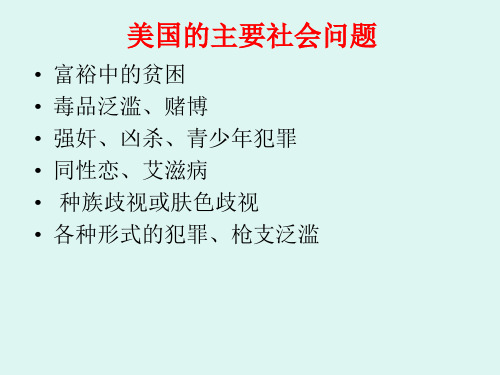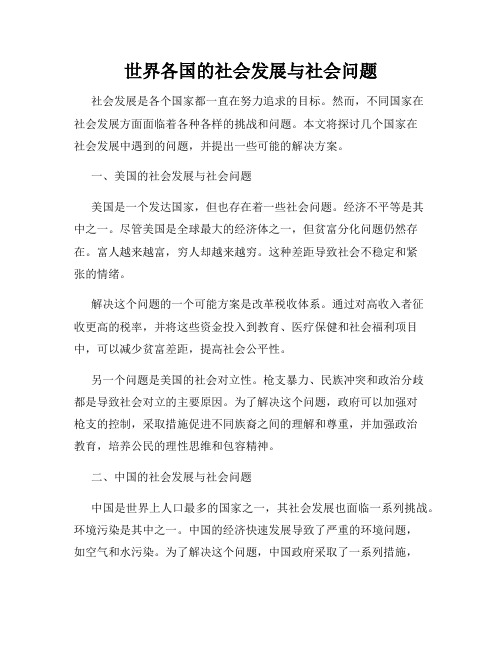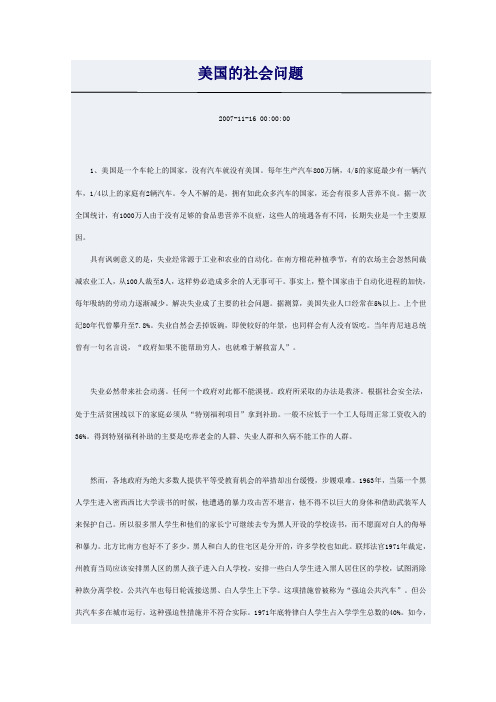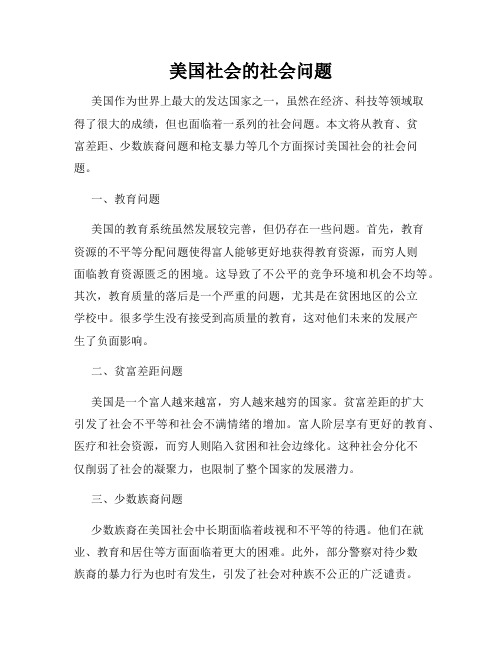美国面临的社会问题
_美国社会问题

• • • • • • 富裕中的贫困 毒品泛滥、赌博 强奸、凶杀、青少年犯罪 同性恋、艾滋病 种族歧视或肤色歧视 各种形式的犯罪、枪支泛滥
一、美国被列为世界最富有国家之一,
其贫困问题却名列工业国家榜首。
• 80年代,贫困率是英、法、西德、瑞士、荷兰等 国的2倍 • 1983年,生活在贫困线以下的美国人为3530万 • 90年代,靠施舍过活动人已达4300万(占美国人 口17.2%),此外,还有300—400万露宿街头的 无家可归者 • 据一次全国统计,有1000万人由于没有足够的食 品患营养不良症,这些人的境遇各有不同,长期 失业是一个主要原因。
吸毒原因
• • • • 精神压抑,寻求解脱 尝试禁果,填补空虚 大众传媒的不良影响 毒品泛滥,推销有术
反毒品斗争及其失败原因
• 滋生吸毒的社会土壤肥沃 • 毒品集团势力强大,手段狡猾 • 步调不一,打击不力
三、美国枪支问题 • 美国是西方世界中法律允许私人拥 有枪支的唯一国家
美国宪法第二条修正案
弗吉尼亚理工大学学生举行悼念集会
四、种族歧视或肤色歧视也是美国社会的大 问题,主要表现在对待黑人的人格和尊严上。
• 由于技能低下和受教育不够,造成黑人就业率不足。据统 计,美国有11.8%的人口处于贫困线,大约为2500万人, 其中绝大多数是黑人。住房也反映着种族歧视。白人不愿 与黑人做邻居。如有黑人移居白人居住的地区,一些富庶 的白人将会搬家,另觅他处。居住在“城里”的多是一些 收入低下的黑人农业工人、黑人林业工人和黑人矿工。这 样就形成了贫民区和种族隔离区。 • 黑人面临的另一个可怕问题是“三K党”的迫害。“三K 党”1915年成立,由南方顽固坚持白人优越的恐怖分子所 组成。由于黑人的长期斗争和正义白人的支持,“三K党” 的恶行后来有所收敛,但直至今日恐怖活动仍不时发生
美国现状分析报告

美国现状分析报告
美国现状分析报告
2021年对美国来说是一个极具挑战的一年。
在新冠疫情的冲击下,美国经济受到了严重的打击,许多企业倒闭,失业率飙升。
同时,种族问题和社会不平等问题也引发了大规模的抗议活动,导致社会紧张局势升级。
经济方面,尽管美国政府推出了大规模刺激计划,包括直接向个人发放钱款以刺激消费,但经济复苏的速度仍然较为缓慢。
失业率仍然居高不下,许多家庭仍然面临着经济困境。
此外,疫情还导致了全球供应链的中断,给许多行业带来了困难。
社会方面,美国在2020年经历了一系列的示威活动和骚乱,主要是因为对种族歧视和警察暴力的不满。
这些活动引发了对警队改革和社会正义的讨论。
美国社会存在较大的撕裂,民众在种族、政治、经济等方面存在着严重的分歧。
此外,美国政治局势也不稳定。
2020年的总统选举在特朗普和拜登之间展开了激烈的争夺。
选举结果的争议以及1月6日的国会暴乱引发了对美国民主制度和选举公正性的质疑。
美国政府的决策透明度和民主制度面临着新的考验。
在国际舞台上,美国与中美关系和中俄关系进一步紧张。
特朗普政府采取了一系列对华政策,包括贸易争端和技术战略的对抗。
拜登政府对中美关系采取的立场仍然不明确,但也预计将继续关注人权和知识产权等问题。
总体而言,美国现状面临着许多挑战和不确定性。
新冠疫情的持续影响、社会不平等问题、政治分裂和国际局势的紧张都给美国带来了许多影响。
然而,美国也具有强大的创新能力和应对能力,相信可以度过目前的困境,迎接未来的挑战。
美国的情况总结范文

一、政治方面美国政治体制为总统制,实行三权分立。
近年来,美国政治氛围日益紧张,两党斗争激烈,政治极化现象严重。
特朗普执政时期,美国推行“美国优先”政策,导致美国在国际事务中的影响力有所下降。
拜登政府上台后,虽然调整了一些政策,但美国政治分裂局面并未得到根本改变。
二、经济方面美国是世界上最大的经济体,拥有强大的科技创新能力和丰富的资源。
然而,美国经济也存在诸多问题。
首先,美国债务规模巨大,甚至超过了国内生产总值。
其次,贫富差距持续扩大,中产阶级生活水平下降。
此外,金融市场波动较大,经济复苏基础不稳固。
三、军事方面美国拥有全球最强大的军事力量,其军事战略遍布世界各地。
然而,美军在海外驻军和干预行动中,也暴露出诸多问题。
如美军在阿富汗、伊拉克等地的战争,不仅给当地民众带来巨大痛苦,也使美军付出了巨大代价。
近年来,美军在亚太地区的军事部署引发地区紧张局势。
四、科技方面美国在科技创新领域一直处于世界领先地位,拥有众多世界知名科技企业和研究机构。
然而,近年来,美国在科技创新方面面临诸多挑战。
一方面,我国等新兴经济体在科技领域的崛起,对美国科技霸权地位构成挑战。
另一方面,美国内部科技创新能力有所下降,创新动力不足。
五、社会问题美国社会问题繁多,如枪支暴力、毒品泛滥、种族歧视等。
近年来,美国枪支暴力事件频发,严重威胁民众生命安全。
毒品问题也日益严重,对美国社会造成巨大危害。
此外,种族歧视问题在美国社会根深蒂固,严重影响了社会和谐。
总之,美国在取得巨大成就的同时,也面临着诸多挑战和危机。
政治分裂、经济困境、军事压力、科技创新乏力以及社会问题等,都预示着美国未来发展充满不确定性。
美国能否克服这些问题,实现持续发展,还有待观察。
世界各国的社会发展与社会问题

世界各国的社会发展与社会问题社会发展是各个国家都一直在努力追求的目标。
然而,不同国家在社会发展方面面临着各种各样的挑战和问题。
本文将探讨几个国家在社会发展中遇到的问题,并提出一些可能的解决方案。
一、美国的社会发展与社会问题美国是一个发达国家,但也存在着一些社会问题。
经济不平等是其中之一。
尽管美国是全球最大的经济体之一,但贫富分化问题仍然存在。
富人越来越富,穷人却越来越穷。
这种差距导致社会不稳定和紧张的情绪。
解决这个问题的一个可能方案是改革税收体系。
通过对高收入者征收更高的税率,并将这些资金投入到教育、医疗保健和社会福利项目中,可以减少贫富差距,提高社会公平性。
另一个问题是美国的社会对立性。
枪支暴力、民族冲突和政治分歧都是导致社会对立的主要原因。
为了解决这个问题,政府可以加强对枪支的控制,采取措施促进不同族裔之间的理解和尊重,并加强政治教育,培养公民的理性思维和包容精神。
二、中国的社会发展与社会问题中国是世界上人口最多的国家之一,其社会发展也面临一系列挑战。
环境污染是其中之一。
中国的经济快速发展导致了严重的环境问题,如空气和水污染。
为了解决这个问题,中国政府采取了一系列措施,如实施更严格的环境保护法规、鼓励清洁能源的使用、加强环境监测等。
另一个社会问题是城乡差距。
中国的城市发展相对较快,但农村地区的经济和社会发展滞后。
为了解决这个问题,政府可以推动农村地区的经济发展,提供更多的教育和医疗资源,并改善农村基础设施建设。
三、印度的社会发展与社会问题印度是一个人口众多、多元文化的国家,其社会发展也面临一些问题。
贫困是其中之一。
尽管印度的经济增长迅速,但大量人口仍然生活在贫困线以下。
政府可以通过提供就业机会、提高教育水平和加强社会保障来减轻贫困问题。
另一个问题是性别不平等。
尽管印度有很多女性在政治和经济领域取得了重要进展,但性别歧视仍然存在。
政府可以加强对性别歧视的打击,鼓励女性参与社会和经济活动,并提供平等的教育和就业机会。
社会问题的反思回顾美国往事

社会问题的反思回顾美国往事近年来,美国社会问题的矛盾日益凸显,引起了广泛的关注和深思。
回顾美国往事,我们不仅可以看到其光辉的历史和辉煌的成就,更能寻找到一些深层次的根源,以及对社会问题的反思。
一是种族问题。
美国历史上的种族问题一直是其社会进步过程中难以绕过的坎。
在奴隶制度时代,黑人受到了严重的歧视和侵犯。
废奴运动和南北战争打破了奴隶制,黑人获得了解放和公民权。
然而,实际上,黑人在接下来的几十年中仍受到了严重的歧视和压迫。
60年代的民权运动领导者马丁•路德•金为黑人争取到了平等权益,但是现在的美国仍然存在着种族问题。
默默无闻的种族歧视、警察暴力执法等问题,揭示了美国社会对种族平等的反思和反复。
二是社会不平等。
美国是一个强调自由和平等的国家,然而社会不平等问题一直悬在美国的头顶。
贫富差距日趋扩大,中产阶级的生活水平逐渐下降,而富裕阶层的财富不断积累。
这种不公平不仅存在于经济领域,也涉及到教育、医疗等社会资源的分配。
穷人和弱势群体的福利问题一直是美国社会亟待解决的重要议题。
三是枪支问题。
美国是世界上枪支拥有量最高的国家之一,枪支问题成为美国面临的长期社会问题。
枪支暴力事件频发,给美国社会造成了巨大的伤害。
尽管有人主张枪支限制,但是美国的枪支文化和保卫个人权利的思维仍根深蒂固。
如何在确保公共安全的前提下解决枪支问题成为了美国社会面对的挑战。
四是气候变化问题。
作为全球最大的温室气体排放国,美国的气候变化问题已经引起了全球的关注。
然而,在政治和经济利益上的考虑,一直阻碍了美国对气候变化问题的有效应对。
这个社会问题不仅涉及到美国自身的环境和可持续发展,也对全球气候治理形成了重大的阻碍。
通过回顾美国往事,我们可以看到这些社会问题在美国的历史过程中几经反复。
然而,这些问题的根源并没有被根本解决,仍然困扰着美国社会的进步。
对于这些社会问题的反思和思考势在必行。
只有在思维的引导下,通过政策和制度的变革,才能够让美国社会走出这些问题的困境。
美国的陷落美国社会与的困境与变革

美国的陷落美国社会与的困境与变革美国的陷落:社会困境与变革美国是一个拥有悠久历史和多元文化的大国,然而近年来,它也面临着前所未有的社会困境与变革。
从不断上升的经济差距到加剧的种族问题,这些挑战威胁着美国的社会稳定和未来发展。
本文将探讨美国当前的困境,并探讨可能的变革途径。
一、经济差距的加剧近年来,美国的经济差距不断扩大,贫富分化日益明显。
资本主义经济模式使得少数人获取了巨大财富,而大多数人却陷入贫困。
富人越来越富,穷人越来越穷的现象凸显了社会不公平的问题。
为了解决这一困境,美国政府需要采取针对性的政策。
首先,税收制度应该针对高收入群体进行改革,增加对富人的征税比例,以减小贫富差距。
其次,政府还应建立更为公平的福利制度,确保资源的合理分配,提供更多的教育、医疗和公共服务,以帮助弱势群体尽快脱贫。
二、种族问题的加剧美国是一个多民族国家,种族关系一直是社会的敏感问题。
然而,近年来,种族问题日益加剧,社会紧张局势增大,种族歧视现象仍然存在。
为了解决这一困境,需要全社会共同努力。
政府应加强种族平等教育,提升公民意识,消除对于不同种族的偏见与歧视。
同时,建立更加公正的法律体系,加强对于种族歧视的惩治力度,保护弱势群体的权益。
三、政治分歧的加深政治分歧是当今美国社会的又一大困境。
不同政治派别之间的对立导致了政府决策的阻碍,使得社会问题的解决变得更加困难。
为了解决这一困境,政府需要加强双方的对话与沟通,推动政治协商,寻求共识。
同时,公众也应理性对待政治议题,摒弃极端观点,以实际行动推动社会的发展。
四、环境危机的威胁环境问题是全球面临的挑战,美国也不例外。
空气污染、气候变化等环境问题对美国社会带来了巨大的困境与变革。
为了解决这一困境,美国政府应加大环境保护力度。
加强对于环境破坏者的制裁,制定更加严格的环保法律法规,促进可再生能源的发展,减少对化石燃料的依赖,以实现环境可持续发展。
结语美国当前的困境与变革是一个复杂而艰巨的课题,但也是一个充满机遇的时刻。
美国社会问题演讲稿

美国社会问题演讲稿
尊敬的各位领导,亲爱的同事们:
今天我想和大家谈谈美国社会面临的一些问题。
美国是一个多元化、自由的国家,但是我们也面临着许多社会问题。
这些问题不仅影响着我们每个人的生活,也影响着整个社会的稳定和发展。
因此,我们需要认真思考这些问题,并寻找解决之道。
首先,让我们来谈谈贫富差距。
在美国,贫富差距越来越大,富人越来越富,穷人越来越穷。
这种不公平的现象使得社会的阶层分化越来越严重,造成了社会的不稳定和不公平。
我们需要采取措施来缩小贫富差距,让每个人都有机会获得成功和幸福。
其次,我们需要关注种族歧视问题。
在美国,种族歧视问题依然存在。
许多少数族裔和移民群体面临着歧视和不公平待遇。
这种现象不仅伤害了受害者的权益,也损害了整个社会的和谐和稳定。
我们需要采取措施来消除种族歧视,让每个人都能够平等地获得尊重和机会。
最后,我想谈谈教育问题。
在美国,教育资源的分配不均导致
了教育质量的差异。
许多贫困地区的孩子们无法获得良好的教育资源,这使得他们失去了追求美好生活的机会。
我们需要改革教育体系,让每个孩子都能够获得优质的教育,实现自己的梦想。
在面对这些问题时,我们需要团结一心,共同努力。
政府、企业和社会各界都应该为解决这些问题贡献自己的力量。
只有通过共同的努力,我们才能够建设一个更加公平、和谐的社会。
最后,让我们共同努力,为美国社会的发展和进步贡献自己的力量。
谢谢大家!。
美国现代政治和社会问题的历史背景分析

美国现代政治和社会问题的历史背景分析美国的现代政治和社会问题已经成为全球瞩目的焦点。
在过去的几十年中,美国一直面临着诸如贫富分化、移民问题、枪支暴力、环境污染等一系列社会问题。
这些问题虽然看起来似乎是这个国家独有的,但实际上它们都有深刻的历史背景和文化根源。
在本文中,我们将尝试探讨一下这些问题的源头和历史背景,以便更好地理解这个国家的现代政治和社会问题。
经济与社会问题首先,让我们看看美国的经济和社会问题。
美国经济的发展源远流长,早在十九世纪末,它就已经成为了世界上最富裕的国家之一。
然而,在这样一个富裕的国家中,贫富分化却变得越来越严重。
根据经济学家的研究,自1970年代以来,美国的贫富差距一直在不断扩大。
这一趋势越来越明显,越来越多的人将其视为一个十分严重的社会问题。
那么,这个问题的根源是什么呢?一方面,美国的经济制度可能是导致贫富差距扩大的一个主要原因。
美国一直坚持市场经济,认为市场竞争可以为人们创造更好的物质条件。
但是,市场经济也有一种负面影响,即将贫富分化。
这是因为市场在本质上是一个竞争的游戏,赢家通吃。
在这个游戏中,那些技能、教育和资本拥有者往往是最优胜者。
另一方面,美国的文化也可能是导致贫富差距扩大的原因之一。
美国的文化强调竞争和成功的价值,这在某种程度上鼓励人们争夺成功和好的工作。
在这个过程中,那些没有这些资源的人往往会落在后面。
此外,美国的教育和社会资本也往往与个人的家庭背景有关。
这种不平等往往会扩大贫富差距。
移民和种族问题另一个主要的美国社会问题是移民和种族问题。
自十八世纪以来,美国一直是一个移民国家,在很长一段时间里,美国因自由主义和机会主义而吸引了来自世界各地的人。
然而,自1980年代以来,大规模移民导致了美国的种族和文化多样性前所未有的增长。
这也导致了更多的种族问题,包括种族主义、种族隔离和种族歧视。
移民和种族问题的根源同样与美国的历史和文化有很大关系。
随着南北战争的结束,黑奴们获得了自由,并在美国的社会体系中逐渐占据了重要地位。
浅析美国社会现象

浅析美国社会现象美国社会现象种族歧视:自从奴隶制度被废除以来,美国便一直面临着严重的种族歧视问题。
无论是否公开表态,这种歧视感受对很多人来说都是很真实的。
在许多公共场所,如学校,工作场所,政府机构以及警察局,黑人和拉丁裔美国人普遍面临着不公正对待。
这并不仅仅是一些个人行为所导致的,而是一个由来已久的系统性问题。
虽然美国已经采取了一些措施来解决这种问题,但仍有很长的路要走。
贫富分化:美国是一个典型的资本主义国家,这意味着个人的成功和命运很大程度上取决于自己的经济状况。
然而,正是在这个“自由市场”的基础上,美国社会也产生了越来越大的贫富分化问题。
富人越来越富,穷人也越来越穷。
这种差距在美国历史上从未如此悬殊过。
对于很多人来说,他们不仅无法获得物质财富,而且还缺乏基本的医疗保健和居住条件。
极端主义:美国议会大厦被攻击的画面在世界各地引起轩然大波。
这不是美国政治生态的一个孤立事件。
近年来,种族主义、白人至上主义和极右翼极端主义在美国显现出越来越强的力量。
这种言论和行为的危害性不容小觑,他们的观点和做法都是在消解和破坏着美国社会的核心价值观。
枪支暴力:美国的枪支问题一直是一个热门话题。
枪支使用不当导致的暴力行为,包括屠杀式枪击事件,仍然是美国社会面临的最严峻问题之一。
这些事件表明,枪支问题涉及许多不同的方面,包括枪支管理问题,以及与心理健康和暴力文化有关的问题。
结语:美国社会面临众多复杂的问题,这些问题都影响到了美国作为一个国家的核心价值观。
建立一个更稳定的,更公正的美国社会,需要全民参与,需要媒体,政府和普通人的行动。
政府应该采取更多措施来解决种族歧视问题,包括改善教育公平,加强警察部门的监管以及推行更加多元化的招聘政策。
此外,政府也应该打造适合所有人的社会保障体系,为贫困人口提供经济和医疗等支持。
政府也应该推动提高最低工资,以确保所有人能够获得相应的薪酬和生活条件。
对于极端主义和枪支问题,政府应该严格监管和控制极端主义诉求和暴力行为,加强宣传教育,推进多元文化和宽容观念,以消解这类极端主义思想的影响。
美国的社会问题

有的学校82%的学生已经是黑人了。
原因是白人学生惟恐避黑人学生而不远。
在华盛顿,有很多白人移居郊区,不愿与黑人为伍,从而使黑人学生从57%增至96%。
至今,人们还在争论实行“强迫公共汽车”制度是否有必要,以致热衷于此项规定的人士也逐渐动摇起来。
由于技能低下和受教育不够,造成黑人就业率不足。
据统计,美国有11.8%的人口处于贫困线,大约为2500万人,其中绝大多数是黑人。
住房也反映着种族歧视。
白人不愿与黑人做邻居。
如有黑人移居白人居住的地区,一些富庶的白人将会搬家,另觅他处。
居住在“城里”的多是一些收入低下的黑人农业工人、黑人林业工人和黑人矿工。
这样就形成了贫民区和种族隔离区。
黑人面临的另一个可怕问题是“三K党”的迫害。
“三K党”1915年成立,由南方顽固坚持白人优越的恐怖分子所组成。
由于黑人的长期斗争和正义白人的支持,“三K党”的恶行后来有所收敛,但直至今日恐怖活动仍不时发生。
4、美国人口在2000年已有3亿,2020年将达4亿。
美国商业部估计,1969年每人平均收入为3400美元,2000年为8300美元。
美国现有民用汽车1.1亿辆,商用汽车1.5亿辆。
人口增加意味着汽车增加。
人口增长带来的收入增长,必然造成消费的增长。
这些增长被用在汽车、房屋和其它物质消耗上,势将造成灾难性资源消耗和污染。
污染问题如今已经成为全社会所关注的大问题。
人口的不断增加,伴之生活水平的不断提高,不仅将消耗美国的资源,也必消耗全世界的资源,由此造成的又将污染人口密集的环境,给地球居民的健康造成损害。
烟雾曾给人们造成烦恼,但那时人们对于烟雾的认识还是极其肤浅的,如今才认识到它对人类健康的危害是多麽巨大。
人们也曾津津乐道汽车带给自己的快捷和享受,今天才知道它原来是造成污染破坏环境的要犯。
曾几何时,人们曾为重工业对人类社会的贡献引吭高歌过,但它对河流、土地和空气的污染是显而易见的,它造成的声音污染和视觉污染也是有目共睹的。
如今,大家都清楚DDT和其它化学药物给人们带来的生态危害远远超出它带给人类的好处。
美国社会的社会问题

美国社会的社会问题美国作为世界上最大的发达国家之一,虽然在经济、科技等领域取得了很大的成绩,但也面临着一系列的社会问题。
本文将从教育、贫富差距、少数族裔问题和枪支暴力等几个方面探讨美国社会的社会问题。
一、教育问题美国的教育系统虽然发展较完善,但仍存在一些问题。
首先,教育资源的不平等分配问题使得富人能够更好地获得教育资源,而穷人则面临教育资源匮乏的困境。
这导致了不公平的竞争环境和机会不均等。
其次,教育质量的落后是一个严重的问题,尤其是在贫困地区的公立学校中。
很多学生没有接受到高质量的教育,这对他们未来的发展产生了负面影响。
二、贫富差距问题美国是一个富人越来越富,穷人越来越穷的国家。
贫富差距的扩大引发了社会不平等和社会不满情绪的增加。
富人阶层享有更好的教育、医疗和社会资源,而穷人则陷入贫困和社会边缘化。
这种社会分化不仅削弱了社会的凝聚力,也限制了整个国家的发展潜力。
三、少数族裔问题少数族裔在美国社会中长期面临着歧视和不平等的待遇。
他们在就业、教育和居住等方面面临着更大的困难。
此外,部分警察对待少数族裔的暴力行为也时有发生,引发了社会对种族不公正的广泛谴责。
这些问题严重影响了少数族裔群体的平等权益,损害了社会的整体公平与正义。
四、枪支暴力问题美国面临着严重的枪支暴力问题。
根据统计数据,美国每年都有大量的枪支暴力事件发生,导致了大量的人员伤亡。
这种枪支暴力问题不仅威胁到人民的生命安全,也造成了社会的不安定和恐慌。
然而,由于枪支在美国具有特殊的历史和文化背景,以及相关法律的限制,这个问题一直未能得到有效解决。
总结美国社会面临着多方面的社会问题,其中教育、贫富差距、少数族裔问题和枪支暴力问题是其中的重要方面。
为了改善这些社会问题,美国政府和社会各界需要加大力度进行改革和创新,通过改进教育体制、减少贫富差距、消除种族歧视和加强枪支管控等措施,使美国社会更加公正、稳定和繁荣。
只有这样,美国才能更好地实现全体人民的共同繁荣和幸福。
美国社会问题辩论辩题

美国社会问题辩论辩题正方,美国社会存在严重问题,需要引起重视。
作为正方辩手,我认为美国社会存在着诸多问题,需要引起重视和解决。
首先,美国社会存在着严重的种族歧视问题。
历史上,美国曾经经历过种族隔离和种族歧视的时期,虽然现在已经废除了种族隔离政策,但是种族歧视问题仍然存在。
例如,非裔美国人在就业、教育、医疗等方面仍然面临着不公平待遇。
这种情况引起了美国社会的广泛关注,甚至引发了一系列的抗议活动,如“黑人命也是命”运动。
正如马丁·路德·金曾经说过,“我有一个梦想,那就是我的四个孩子将不会因为肤色而受到歧视。
”这句话表达了对种族歧视的反对和呼吁。
其次,美国社会存在着严重的贫富分化问题。
据统计数据显示,美国的贫富差距正在不断扩大,富人越来越富,穷人越来越穷。
这种贫富分化不仅影响了社会的和谐稳定,也加剧了社会的不公平现象。
正如美国前总统富兰克林·罗斯福曾经说过,“自由的真正测试是不平等的承受力。
”这句话表达了对贫富分化的关注和担忧。
最后,美国社会还存在着严重的枪支暴力问题。
枪支暴力已经成为了美国社会的一大顽疾,每年都有大量的枪支暴力事件发生,给社会带来了极大的伤害和恐慌。
正如美国著名演员摩根·弗里曼曾经说过,“枪支暴力是一个问题,而不是解决问题的方式。
”这句话表达了对枪支暴力问题的反对和呼吁。
综上所述,美国社会存在着严重的种族歧视、贫富分化和枪支暴力等问题,这些问题需要引起重视并且采取有效措施加以解决。
反方,美国社会问题并不严重,存在一些问题是正常的。
作为反方辩手,我认为美国社会并不存在严重的问题,一些问题是正常的,不必过分夸大。
首先,关于种族歧视问题,美国社会已经取得了显著的进步,种族隔离政策已经废除,种族歧视现象也在逐渐减少。
虽然在一些方面还存在不公平现象,但是这并不代表整个社会都存在着严重的种族歧视问题。
美国前总统巴拉克·奥巴马曾经说过,“我们可能不会立刻解决所有的问题,但是我们可以迈出前进的一步。
美国的不安因素

美国的不安因素
美国目前面临的一些不安因素包括:
1. 社会不公:美国存在严重的贫富差距和社会阶层分化问题,黑人和其他少数族裔经常面临歧视和不平等待遇。
2. 经济下滑:全球金融危机以及新冠疫情对美国经济造成了重大的冲击,导致失业率飙升,许多企业面临倒闭或裁员。
3. 移民问题:美国的移民政策一直备受争议,尤其是在特朗普政府时期,针对非法移民的政策变得更为严厉,引发了国内外的激烈争议。
4. 枪支暴力:美国的枪支暴力问题一直存在,频繁发生校园枪击案和社区暴力事件,导致人们对安全和公共秩序的担忧。
5. 政治分裂:近年来,美国的政治氛围越来越极化,两之间的分歧日益加深,政策制定和决策变得困难,造成政府运转问题。
6. 气候变化:气候变化对全球都构成威胁,但美国政府在这个问题上的立场一直分裂,导致国内相关政策的推进受阻。
7. 恐怖主义和网络安全:恐怖袭击和网络攻击是威胁美国国家安全的重要因素,
对公众的安全感造成严重影响。
这些不安因素共同造成了美国社会的紧张和不稳定,国内各界都在积极寻求解决方案以缓解这些问题的影响。
美国社会保障制度的困境和社会问题

美国社会保障制度的困境和社会问题美国社会保障制度的困境和社会问题1935年8月14日,《社会保障法》的签署标志着美国社会保障制度的正式确立,但其援助对象却仅限于65岁及以上的老年人、盲人、未成年人和残疾儿童。
二战后至20世纪60年代末,美国社会保障政策逐步完善,内容涉及个人的衣、食、住、行、生、老、病、死等诸多方面,使美国社会保障形成特色,并成为名副其实的“福利国家”。
1970年后,随着凯恩斯主义政策的失灵,美国的社会保障制度逐渐陷入困境,社会保障的负面效应日益显现出来,与之相关的社会问题成为政府与民众关注的焦点。
一、社会保障与财政危机美国的社会保障分为三大类:社会保险、社会救济和社会福利。
社会保险项目主要有老年保险、伤残保险、失业保险、工伤事故保险和医疗保险。
社会救济项目主要包括:“补充收入保障”(对65岁以上未得到社会保险的贫困老人、盲人和残疾人发放救济金)、“抚养未成年子女家庭补助计划”、“医疗补助”和“食品券补贴”。
社会福利项目主要有公共医疗保健、教育津贴和“公共住宅补贴”。
社会保障援助对象扩及失业工人、退伍军人等在内的各个阶层和群体,社会保障的项目也多达300多项。
加之领取者标准的降低,社会保障的受益人数持续增多。
随着科技的进步与社会的发展,生活必需品的价格上涨,社会保障各项目最低标准提高,开支不断扩大。
以医疗保障为例,医疗手段的现代化使美国的医疗费用迅速上升。
心脏搭桥手术的费用1970年为1.4万美元老年人,到1991年增至40.7万美元,涨幅惊人。
许多医生为避免治疗不当引起诉讼,往往从事“防御式行医”,即让病人做许多不必要的化验并常常要求其他医生会诊,使患者支付了一定数额的不必要的医疗费用。
“第三方付费”的付款方式也没能鼓励病人和医生在要求活建议化验和治疗方面实行节约。
医生不考虑廉价实惠的药方和治疗手段,患者及其家属也往往追求费用高昂但风险小、治疗效果好的医治手段,造成许多代价昂贵的技术过度使用。
美国社会问题辩论辩题

美国社会问题辩论辩题正方观点,美国社会存在诸多问题,需要积极解决。
作为正方辩手,我认为美国社会存在诸多问题,需要积极解决。
首先,美国的贫富差距日益扩大,这导致社会不公平现象严重。
根据皮尤研究中心的数据显示,美国最富有的1%拥有的财富已经超过了整个中产阶级的总和。
这种贫富差距不仅影响了社会的稳定,也使得贫困人口无法获得基本的教育、医疗等资源,从而加剧了社会的不公平现象。
其次,美国存在着严重的种族歧视问题。
无论是在就业、教育还是司法系统中,非裔美国人和其他少数族裔都面临着不公平待遇。
例如,美国司法系统中存在的种族歧视问题已经引发了多起引起社会广泛关注的案件,如乔治·弗洛伊德之死。
这些问题的存在,严重影响了美国社会的和谐与稳定。
此外,美国的枪支暴力问题也是亟待解决的社会问题。
根据统计数据显示,美国每年有数千人死于枪支暴力事件,这种暴力不仅威胁了人民的生命安全,也加剧了社会的恐慌和不安。
因此,我们需要积极解决这些问题,通过政府的政策调整和社会的共同努力,来缩小贫富差距、消除种族歧视、加强枪支管控,从而建设一个更加公平、和谐和安全的美国社会。
反方观点,美国社会问题并不严重,不需要过分夸大。
作为反方辩手,我认为美国社会问题并不严重,不需要过分夸大。
首先,贫富差距是由市场经济自然形成的,富人的财富是通过自己的努力和智慧获得的,不存在不公平现象。
正如亚当·斯密所说,“每个人都为自己而工作,却常常不自觉地为全社会工作。
”财富的不平等是市场经济的必然结果,不存在不公平问题。
其次,美国的种族歧视问题也被过分夸大。
美国已经通过多项法律禁止了种族歧视行为,对于种族歧视行为也会受到严惩。
同时,美国社会也在积极推动种族平等和多元文化的发展,种族歧视并不是社会的主要问题。
再者,枪支暴力问题也不是美国社会的主要问题。
枪支在美国社会中具有重要的地位,合法拥有枪支也是美国公民的权利之一。
同时,枪支暴力事件在美国社会中并不是主流现象,绝大多数的美国人生活在相对安全的环境中。
美国社会问题辩论辩题

美国社会问题辩论辩题正方,美国社会存在严重问题,需要解决。
作为正方辩手,我认为美国社会存在诸多严重问题,需要得到解决。
首先,我们可以看到美国存在严重的种族歧视问题。
例如,美国历史上曾经存在黑人奴隶制度,虽然已经废除,但种族歧视问题仍然存在于社会各个层面。
美国著名黑人权利领袖马丁·路德·金曾说过,“我梦想有一天,我的四个孩子将不被人们以肤色,而是以品格的优劣来评判。
”这句话表达了对种族歧视的深刻反思。
此外,社会贫富分化也是美国社会面临的严重问题。
据统计,美国最富有的1%人口拥有了全国70%的财富,而最贫困的20%人口只拥有不到1%的财富。
这种贫富分化导致了社会不公平现象的加剧,加剧了社会的不稳定性。
正如美国前总统富兰克林·罗斯福所说,“自由不是财富的保障,但贫困是自由的威胁。
”。
最后,美国社会还存在着严重的枪支暴力问题。
每年都有大量的枪支暴力事件发生,给社会带来了极大的伤害和恐慌。
例如,2012年康涅狄格州的桑迪胡克小学枪击事件,造成了20名儿童和6名成人的死亡。
这些事件表明了美国的枪支管理问题亟待解决。
综上所述,美国社会存在严重的种族歧视、贫富分化和枪支暴力等问题,这些问题需要得到解决。
正如美国前总统巴拉克·奥巴马所说,“变革不会来自于政府,而是来自于人民。
”只有全社会的努力,才能解决这些问题,实现社会的和谐与稳定。
反方,美国社会问题并不严重,不需要过分夸大。
作为反方辩手,我认为美国社会问题并不像正方所说的那样严重,不需要过分夸大。
首先,我们可以看到美国社会在种族问题上已经取得了一定的进步。
例如,美国已经通过了《民权法案》,禁止了种族歧视行为,同时也出台了一系列的政策来促进种族平等。
虽然种族问题还存在,但并不是像正方所说的那样严重。
其次,贫富分化在美国社会中并不是一个新问题。
贫富分化是市场经济下的必然现象,而且在美国这样一个自由市场经济体系下更是不可避免的。
美国社会的多元化与社会问题

美国社会的多元化与社会问题当谈论美国社会时,多元化是一个不可避免的话题。
美国是一个拥有千差万别文化背景和群体的国家,尽管美国政治和社会历史上存在一些暴力的民族隔离事件,但美国最终走向的是和谐多元化的社会。
然而,多元化也给美国带来了一些社会问题。
本文将探讨美国社会的多元化与社会问题。
多元化是美国社会的一个显著特征。
美国是一个移民国家,全球各地的人们都涌入美国,形成了一个多元化的社会。
据统计,美国3%的人口表示来自亚太地区、6.5%的人口来自拉丁美洲、12.4%是非裔美国人、17.8%的人口是西欧裔美国人,而54.4%的人口是来自其他地区(根据2010年美国人口普查数据)。
这样的民族构成在全球范围内都是罕见的。
这样的民族多元化意味着美国社会拥有独特的文化和社会背景。
在美国,每一个民族群体都有自己的文化,并有着不同的价值观和生活方式。
虽然多元化是美国社会的一大特征,但这也带来了一些社会问题。
一些人口较少的社会群体可能遭受来自更大的社会群体的歧视和排斥。
此外,由于不同的文化和背景,社会群体之间的交流并不容易,也容易带来误解和冲突。
在过去的几十年中,一些美国城市发生了暴力民族隔离事件,例如1965年华盛顿哥伦比亚特区的“屠场”事件。
这个事件中,黑人群体在和警察的暴力冲突中遭受了枪击和伤亡。
这种社会暴力事件带来长期的影响和后果,不仅导致人员伤亡,而且会使社会群体之间的经济、文化和教育上的隔阂加深。
另外,美国社会的多元化也带来了一些经济问题。
美国的移民群体普遍来自较为贫困的社会群体,他们往往没有文化和社会资源上的优势,很难融入美国社会,甚至难以找到工作和经济机会。
这种现象被称为“社会孤立现象”,它会带来经济和心理上的问题。
此外,在美国,教育资源的分配并不公平,一些来自贫困社会群体的学生往往在教育上面临着较大的困难。
根据一个调查,在美国的学生中,来自穷人家庭的学生普遍成绩较差,他们更难以拥有足够的教育资源,缺少高质量的教育。
美国社会问题辩论辩题

美国社会问题辩论辩题正方观点,美国社会问题需要得到更多关注和解决。
美国作为世界上最发达的国家之一,却面临着诸多社会问题,包括贫富差距、种族歧视、枪支暴力等。
这些问题严重影响了美国社会的稳定和发展,因此需要得到更多关注和解决。
首先,贫富差距是美国社会面临的严重问题之一。
根据《纽约时报》的报道,美国的贫富差距已经达到了历史最高水平,富人越来越富,而贫困人口却在增加。
这种不公平的分配导致了社会的不稳定和不公平,需要得到解决。
其次,种族歧视也是美国社会问题的重要组成部分。
美国历史上曾经存在过种族隔离制度,虽然现在已经废除,但种族歧视依然存在于美国社会中。
例如,2019年发生在明尼苏达州的乔治·弗洛伊德之死事件引发了全国范围内的抗议活动,显示了美国社会中种族歧视问题的严重性。
最后,枪支暴力问题也是美国社会问题的重要方面。
根据《华盛顿邮报》的报道,美国每年有数千人死于枪支暴力事件,这种暴力已经成为了美国社会的一种病态现象。
名人名句中,马丁·路德·金曾经说过,“暴力只能暂时地杀死暴力,它永远不能带来永久的和平。
”这句话深刻地揭示了暴力不能解决问题的本质,因此需要更多的关注和解决。
总之,美国社会问题需要得到更多关注和解决。
只有通过政府、社会和个人的共同努力,才能够解决这些问题,实现美国社会的稳定和繁荣。
反方观点,美国社会问题并不需要过多关注和解决。
美国社会问题的确存在,但并不需要过多关注和解决。
首先,贫富差距是社会发展的必然产物,富人的财富是通过自己的努力和智慧获得的,而贫困人口也有机会通过努力脱贫。
正如亚里士多德所说,“贫富差距是社会的正常现象,是激励人们努力工作的动力。
”因此,并不需要过多关注和解决。
其次,种族歧视问题也并不需要过多关注和解决。
美国已经废除了种族隔离制度,种族歧视问题已经得到了很大程度上的改善。
而且,种族歧视问题是个别案例的问题,并不代表整个社会的问题。
因此,并不需要过多关注和解决。
美国社会问题的历史与现状

美国社会问题的历史与现状美国是一个多元文化和多民族的国家,其繁荣和发展是建立在不断解决社会问题的基础之上。
然而,美国社会问题却不容忽视,它们源远流长,影响深远,以至于在当前社会领域的发展中仍然存在着挑战。
本文将探讨美国社会问题的历史和现状,从而更好地理解和解决这些问题。
一、种族歧视与民权运动美国历史上的一大社会问题是种族歧视及其产生的影响。
自从欧洲人向美洲移民以来,美国便一直存在着对非裔、土著和拉美裔的歧视,这种不公正和不平等的待遇恶劣到令人难以想象的地步。
例如,非裔人口在美国历史上曾经是由于奴隶贸易而被迫贩卖到美国的,而奴隶制度一直存在到1865年才被废除。
即使是在废除奴隶制度之后,黑人仍然遭受歧视,面临着极为恶劣的社会和经济状况。
针对这种不公正待遇,美国历史上出现了不少反歧视和民权运动。
例如,20世纪50年代,著名的民权组织——全国有色人种协进会(NAACP)在美国各地组织了大规模的抗议活动,倡导平等和反歧视。
此外,马丁·路德·金也是20世纪60年代民权运动的重要代表人物之一,他通过游行示威和演讲等方式,号召公民权利和反对种族歧视。
二、性别问题美国社会中存在的另一个重要问题是性别歧视。
在美国历史上,女性绝大多数时间都处于次等地位,被认为不具有和男性一样的社会地位和权利。
例如,美国历史上的婚姻法律和习俗曾经明确规定女性在婚姻中没有同等的法律地位和随同的财产权利。
随着时间的推移,美国社会中对性别歧视的抗议不断增多。
20世纪60年代末至70年代初,女性开始大规模地投身于反战和民权运动,倡导平等的性别地位和权利。
此外,美国历史上出现了很多女性领袖,如苏姗·B·安东尼和伊丽莎白·卡迪·斯坦顿等,他们通过女权主义呼吁平等待遇和权利,改变了社会对女性的偏见和刻板印象。
三、社会不平等社会不平等是指在美国社会中,不同阶层之间存在的巨大的财富和权力差距。
- 1、下载文档前请自行甄别文档内容的完整性,平台不提供额外的编辑、内容补充、找答案等附加服务。
- 2、"仅部分预览"的文档,不可在线预览部分如存在完整性等问题,可反馈申请退款(可完整预览的文档不适用该条件!)。
- 3、如文档侵犯您的权益,请联系客服反馈,我们会尽快为您处理(人工客服工作时间:9:00-18:30)。
世界上私人拥枪数量最多的国家。
2013年底,美国人拥有枪支达到3亿。
大量枪支散布在美国社会,导致枪击事件频繁发生。
根据《今日美国报》报道,2013年美国发生30起死亡4人以上的枪击事件,造成137人死亡。
近年来,美国每年都有10万多人遭遇枪击,其中有3万多人丧命枪口,这些人或是死于枪击暴力犯罪,或是死于自杀、误杀等事件。
美国政府未能采取有效措施管制枪支。
(见注3)The United States is the largest privately owned firearms in the world, the proliferation of firearms, causing serious social problems. ). As of 2013, there were about 300 million guns in the U.S..According to a report published on the USA Today , 137 people died in 30 mass killings – four or more people killed, not including the killer – in 2013. On average, more than 100,000 Americans are being shot each year, and 30,000 deaths are caused by the use of guns.失业率居高不下。
据美国消费者新闻与商业频道网站2013年9月16日报道,2012年美国工人平均失业时间为39.5周,是第二次世界大战以来最严重的一年。
美国最低收入家庭的失业率高达21%,几乎和20世纪30年代大萧条时期所有工人的失业率相同。
2014年美国国情咨文称,即使在复苏之中,许多美国人还是在勉强度日,还有很多人仍然没有工作。
Unemployment rates are high in the US.According to a report by the CNBC on September 16, 2013, in 2012, the average length of unemployment for U.S. workers reached 39.5 weeks, the highest level since World War II. Rates of unemployment for the lowest-income families topped 21 percent, nearly matching the rate for all workers during the 1930s Great Depression. “even in the midst of recovery, too many Americans are working more than ever just to get by... And too many still aren’t working at all.”贫富差距进一步加大。
美国人口普查局2013年9月公布的数据显示,2012年美国贫困人口超过4700万,总体贫困率为15%,大约640万65岁以上的老年人非常贫困。
(见注25)美国国内税收署1913年至2012年的数据显示,美国目前的贫富差距是这一时期最大的。
2012年,美国收入最高的1%的人口集中了19.3%的总收入;美国10%的家庭控制了全美50.4%的总收入,这个数字是自1917年以来最高的。
2009年至2012年,美国收入最高的1%家庭的收入增长了31.4%,占美国全部收入增长的95%;而低收入阶层只增长了0.4%。
(见注26)2014年美国国情咨文称,美国公民的平均工资几乎没有变化,社会不平等加深。
Wealth gap in the US is widening. Statistics released by the U.S. Census Bureau in September 2013 showed more than 47 million U.S. people living in poverty in 2012, and that the poverty rate reached 15 percent. The data also indicated about 6.4 million people aged 65 and older were poor (, November 6, 2013). New research using the U.S. Internal Revenue Service data from 2012 all the way back to 1913 found that the current gap between America’s rich and poor is the widest in history. The richest 1 percent’s share of total household income was a record 19.3 percent in 2012. The top 10 percent of U.S. households controlled 50.4 percent of total income in 2012, thehighest figures seen since 1917. In the U.S., the top 1 percent saw their incomes recover by 31.4 percent during 2009 and 2012, accounting for 95 percent of the total gain recognized in the U.S., whereas the bottom 99 percent had to content themselves with growth of only 0.4 percent (, September 10, 2013). The U.S. 2014 State of the Union noted that average wages in the U.S. have barely budged, and inequality has deepened.社会保障问题重重。
据美国人口普查局2013年9月17日公布的数据,2012年,美国约有4800万人仍然没有医疗保险,占总人口的15.4%。
同时,享受到政府健康保险的人数比例只有小幅上涨,从32.2%增长到32.6%。
与2011年相比,无论是否享受健康保险,人们在卫生保健方面的负担都在不断增加。
(见注29)州政府联邦拨款信息中心认为,2013年,美国政府“关门”影响到的涉及民生的项目包括:大部分K-12(见注30)教育资助项目,为穷人提供的低收入家庭能源补助项目,为妇女、婴儿和儿童提供的特殊补充营养项目,失业保险项目管理基金,以及儿童营养项目和其他在10月1日以后开始的项目。
(见注31)为应对金融危机设立的美国联邦紧急救助项目在2013年12月28日到期,美国参议院未及时决定项目是否延续,导致约130万每周领取300美元失业救济金的失业人员生计受到严重影响。
(见注32)Social security in the US is problematic.A U.S. Census Bureau report released on September 17, 2013 said that in 2012, a total of 15.4 percent, or some 48 million people in the U.S. were uninsured. The share of people relying on the government for health insurance edged up slightly to 32.6 percent, from 32.2 percent a year ago. Whether they have insurance or not, people spent more on health care in 2012 than in 2011 (, September 17, 2013). According to the U.S. Federal Funds Information for States, some major programs, including most K-12 educational-support programs; the Low Income Home Energy Assistance Program for the poor; the Special Supplemental Nutrition Program for Women, Infants and Children; Funds to administer the Unemployment Insurance program; Child nutrition programs and other programs starting on or after October 1 could be affected by the federal government shutdown in 2013 (, September 26, 2013). When the funds run out on December 28, 2013 for a program created during the recession to supplement the federal emergency benefits for jobless people and efforts to renew the benefits stalled in the U.S. Senate, about 1.3 million jobless Americans who were receiving the benefits averaging about 300 dollars a week had been affected(, December 27, 2013).。
